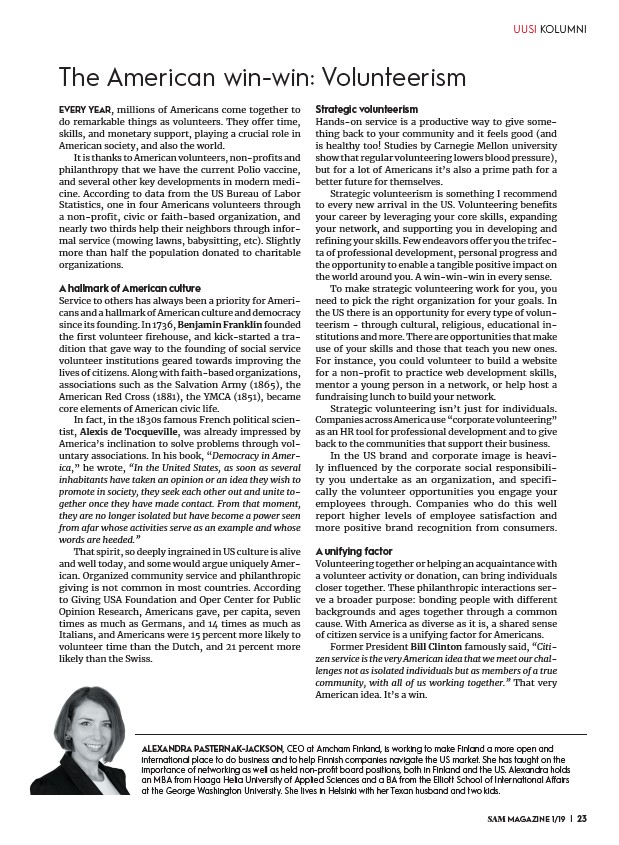
The American win-win: Volunteerism
EVERY YEAR, millions of Americans come together to
do remarkable things as volunteers. They offer time,
skills, and monetary support, playing a crucial role in
American society, and also the world.
It is thanks to American volunteers, non-profits and
philanthropy that we have the current Polio vaccine,
and several other key developments in modern medicine.
According to data from the US Bureau of Labor
Statistics, one in four Americans volunteers through
a non-profit, civic or faith-based organization, and
nearly two thirds help their neighbors through informal
service (mowing lawns, babysitting, etc). Slightly
more than half the population donated to charitable
organizations.
A hallmark of American culture
Service to others has always been a priority for Americans
and a hallmark of American culture and democracy
since its founding. In 1736, Benjamin Franklin founded
the first volunteer firehouse, and kick-started a tradition
that gave way to the founding of social service
volunteer institutions geared towards improving the
lives of citizens. Along with faith-based organizations,
associations such as the Salvation Army (1865), the
American Red Cross (1881), the YMCA (1851), became
core elements of American civic life.
In fact, in the 1830s famous French political scientist,
Alexis de Tocqueville, was already impressed by
America’s inclination to solve problems through voluntary
associations. In his book, “Democracy in America,”
he wrote, “In the United States, as soon as several
inhabitants have taken an opinion or an idea they wish to
promote in society, they seek each other out and unite together
once they have made contact. From that moment,
they are no longer isolated but have become a power seen
from afar whose activities serve as an example and whose
words are heeded.”
That spirit, so deeply ingrained in US culture is alive
and well today, and some would argue uniquely American.
Organized community service and philanthropic
giving is not common in most countries. According
to Giving USA Foundation and Oper Center for Public
Opinion Research, Americans gave, per capita, seven
times as much as Germans, and 14 times as much as
Italians, and Americans were 15 percent more likely to
volunteer time than the Dutch, and 21 percent more
likely than the Swiss.
UUSI KOLUMNI
Strategic volunteerism
Hands-on service is a productive way to give something
back to your community and it feels good (and
is healthy too! Studies by Carnegie Mellon university
show that regular volunteering lowers blood pressure),
but for a lot of Americans it’s also a prime path for a
better future for themselves.
Strategic volunteerism is something I recommend
to every new arrival in the US. Volunteering benefits
your career by leveraging your core skills, expanding
your network, and supporting you in developing and
refining your skills. Few endeavors offer you the trifecta
of professional development, personal progress and
the opportunity to enable a tangible positive impact on
the world around you. A win-win-win in every sense.
To make strategic volunteering work for you, you
need to pick the right organization for your goals. In
the US there is an opportunity for every type of volunteerism
- through cultural, religious, educational institutions
and more. There are opportunities that make
use of your skills and those that teach you new ones.
For instance, you could volunteer to build a website
for a non-profit to practice web development skills,
mentor a young person in a network, or help host a
fundraising lunch to build your network.
Strategic volunteering isn’t just for individuals.
Companies across America use “corporate volunteering”
as an HR tool for professional development and to give
back to the communities that support their business.
In the US brand and corporate image is heavily
influenced by the corporate social responsibility
you undertake as an organization, and specifically
the volunteer opportunities you engage your
employees through. Companies who do this well
report higher levels of employee satisfaction and
more positive brand recognition from consumers.
A unifying factor
Volunteering together or helping an acquaintance with
a volunteer activity or donation, can bring individuals
closer together. These philanthropic interactions serve
a broader purpose: bonding people with different
backgrounds and ages together through a common
cause. With America as diverse as it is, a shared sense
of citizen service is a unifying factor for Americans.
Former President Bill Clinton famously said, “Citizen
service is the very American idea that we meet our challenges
not as isolated individuals but as members of a true
community, with all of us working together.” That very
American idea. It’s a win.
ALEXANDRA PASTERNAK-JACKSON, CEO at Amcham Finland, is working to make Finland a more open and
international place to do business and to help Finnish companies navigate the US market. She has taught on the
importance of networking as well as held non-profit board positions, both in Finland and the US. Alexandra holds
an MBA from Haaga Helia University of Applied Sciences and a BA from the Elliott School of International Affairs
at the George Washington University. She lives in Helsinki with her Texan husband and two kids.
SAM MAGAZINE 1/19 | 23